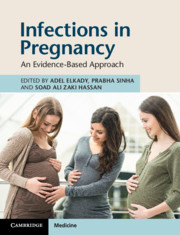Book contents
- Infections in Pregnancy
- Infections in Pregnancy
- Copyright page
- Contents
- Contributors
- Foreword
- Preface
- Section 1 Vaccination
- Section 2 Infections in Pregnancy
- Chapter 2 Viral Hepatitis
- Chapter 3 HIV Infection
- Chapter 4 Herpes Infections and Measles
- Chapter 5 Zika Virus
- Chapter 6 Parvovirus
- Chapter 7 Influenza
- Chapter 8 Cytomegalovirus
- Chapter 9 Dengue Fever
- Chapter 10 Rubella
- Chapter 11 Molluscum Contagiosum
- Chapter 12 Ebola
- Chapter 13 Chikungunya
- Chapter 14 Antibiotics during Pregnancy and Methicillin-Resistant Staphylococcus aureus (MRSA)
- Chapter 15 Gonorrhoea, Syphilis and Lymphogranuloma Venereum
- Chapter 16 Mycoplasma, Ureaplasma, Chancroid, Granuloma Inguinale (Donovanosis)
- Chapter 17 Genital Chlamydia trachomatis and Bacterial Vaginosis
- Chapter 18 Streptococcal Infection
- Chapter 19 Enterococci and Bacterial Infections
- Chapter 20 Listeriosis
- Chapter 21 Urinary Tract Infection
- Chapter 22 Infections and Preterm Labour
- Chapter 23 Appendicitis in Pregnancy
- Chapter 24 Complications Associated with Legal Termination of Pregnancy
- Chapter 25 Tuberculosis
- Chapter 26 Vulvo Vaginitis, Candida (Yeast) Infection
- Chapter 27 Malaria
- Chapter 28 Parasitic Infestation: Protozoa
- Section 3 Postpartum Infections
- Index
- References
Chapter 5 - Zika Virus
from Section 2 - Infections in Pregnancy
Published online by Cambridge University Press: 11 October 2019
- Infections in Pregnancy
- Infections in Pregnancy
- Copyright page
- Contents
- Contributors
- Foreword
- Preface
- Section 1 Vaccination
- Section 2 Infections in Pregnancy
- Chapter 2 Viral Hepatitis
- Chapter 3 HIV Infection
- Chapter 4 Herpes Infections and Measles
- Chapter 5 Zika Virus
- Chapter 6 Parvovirus
- Chapter 7 Influenza
- Chapter 8 Cytomegalovirus
- Chapter 9 Dengue Fever
- Chapter 10 Rubella
- Chapter 11 Molluscum Contagiosum
- Chapter 12 Ebola
- Chapter 13 Chikungunya
- Chapter 14 Antibiotics during Pregnancy and Methicillin-Resistant Staphylococcus aureus (MRSA)
- Chapter 15 Gonorrhoea, Syphilis and Lymphogranuloma Venereum
- Chapter 16 Mycoplasma, Ureaplasma, Chancroid, Granuloma Inguinale (Donovanosis)
- Chapter 17 Genital Chlamydia trachomatis and Bacterial Vaginosis
- Chapter 18 Streptococcal Infection
- Chapter 19 Enterococci and Bacterial Infections
- Chapter 20 Listeriosis
- Chapter 21 Urinary Tract Infection
- Chapter 22 Infections and Preterm Labour
- Chapter 23 Appendicitis in Pregnancy
- Chapter 24 Complications Associated with Legal Termination of Pregnancy
- Chapter 25 Tuberculosis
- Chapter 26 Vulvo Vaginitis, Candida (Yeast) Infection
- Chapter 27 Malaria
- Chapter 28 Parasitic Infestation: Protozoa
- Section 3 Postpartum Infections
- Index
- References
Summary
Zika virus was discovered for the first time in April 1947 in Uganda at Zika forest near Victoria Lake, when a veterinarian and his monkey had the same symptoms (fever, malaise, conjunctivitis and drowsiness). In 1952 infection was proven by a rise in Zika virus-specific antibodies in a Nigerian female.
The first outbreak occurred in April 2007 in Africa and Asia. The second outbreak occurred in May 2015 in South America and Mexico.
In July 2015 some cases were reported in Malaysia, India, Thailand and upper Egypt. The third outbreak occurred at the end of 2016 at the Olympic Games in Brazil.
- Type
- Chapter
- Information
- Infections in PregnancyAn Evidence-Based Approach, pp. 42 - 44Publisher: Cambridge University PressPrint publication year: 2019

